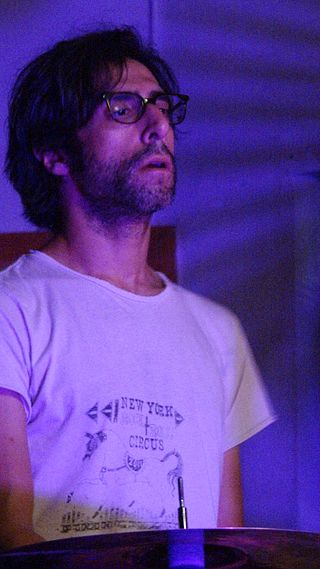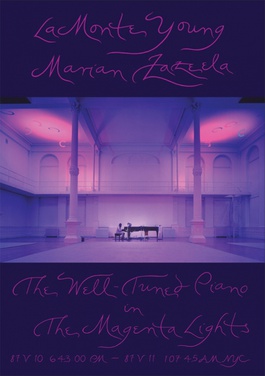
Terrence Mitchell "Terry" Riley is an American composer and performing musician best known as a pioneer of the minimalist school of composition. Influenced by jazz and Indian classical music, his work became notable for its innovative use of repetition, tape music techniques, and delay systems. His best known works are the 1964 composition In C and the 1969 LP A Rainbow in Curved Air, both considered landmarks of minimalism and important influences on experimental music, rock, and contemporary electronic music.

La Monte Thornton Young is an American composer, musician, and performance artist recognized as one of the first American minimalist composers and a central figure in Fluxus and post-war avant-garde music. He is best known for his exploration of sustained tones, beginning with his 1958 composition Trio for Strings. His compositions have called into question the nature and definition of music, most prominently in the text scores of his Compositions 1960. While few of his recordings remain in print, his work has inspired prominent musicians across various genres, including avant-garde, rock, and ambient music.
The Black Album may refer to:

Jon Hassell was an American trumpet player and composer. He was best known for developing the concept of "Fourth World" music, which describes a "unified primitive/futurist sound" combining elements of various world ethnic traditions with modern electronic techniques. The concept was first articulated on Fourth World, Vol. 1: Possible Musics, his 1980 collaboration with Brian Eno.
Pandit Pran Nath was an Indian classical singer and master of the Kirana gharana singing style. Promoting traditional raga principles, Nath exerted an influence on notable American minimalist and jazz musicians, including La Monte Young, Terry Riley, and Don Cherry. He began performing in the United States in the 1970s, and established the Kirana Center for Indian Classical Music in 1972; he subsequently taught in various universities across the US and Europe.
Drone music, drone-based music, or simply drone, is a minimalist genre of music that emphasizes the use of sustained sounds, notes, or tone clusters called drones. It is typically characterized by lengthy compositions featuring relatively slight harmonic variations. La Monte Young, one of its 1960s originators, defined it in 2000 as "the sustained tone branch of minimalism". Music containing drones can be found in many regional traditions across Asia, Australia, and Europe, but the genre label is generally reserved for music originating with the Western classical tradition. Elements of drone music have been incorporated in diverse genres such as rock, ambient, and techno.
Jon Gibson was an American flutist, saxophonist, composer and visual artist, known as one of the founding members of the Philip Glass Ensemble. He was a key player on several seminal minimalist music compositions. He was born in Los Angeles to Charles and Muriel Gibson, both educators, and grew up in El Monte, a suburb.

Brian Chase is an American drummer and drone musician who plays in the New York rock band Yeah Yeah Yeahs. He was ranked at #50 in Gigwise's list of The Greatest Drummers of All Time. He plays drums with traditional grip.
Marian Zazeela is an American light artist, designer, calligrapher, painter and musician based in New York City. She was a member of the 1960s experimental music collective Theatre of Eternal Music, and is known for her collaborative work with her husband, the minimalist composer La Monte Young.

Jim Newman is a film and television producer, contemporary art curator, gallerist and musician.
Shandar was a French record label specializing in avant-garde material that did seminal work during the 1970s releasing, among others, recordings by Albert Ayler, Karlheinz Stockhausen, Steve Reich, Sunny Murray, Philip Glass, Richard Horowitz, Charlemagne Palestine, La Monte Young, Alan Silva, Pandit Pran Nath, Terry Riley, Cecil Taylor and Sun Ra. The records often carry, besides the name Shandar, the logo Shanti.

Dream House 78' 17" is a studio album by minimalist composer La Monte Young, artist Marian Zazeela, and their group the Theatre of Eternal Music. The album was originally released in 1974 by the French label Shandar. The length of the record, almost double what was then normal, was extremely unusual in its time.

New York in the 1960s: Sun Blindness Music, better known as Sun Blindness Music, is an album by John Cale released in 2001. It is the first of a loose anthology of experimental albums recorded during Cale's tenure with the Theatre of Eternal Music during the mid-1960s.

Inside the Dream Syndicate, Vol. I: Day of Niagara or simply Day of Niagara is a bootleg recording of a 1965 performance by the minimalist music group the Theatre of Eternal Music, a.k.a. the Dream Syndicate. Contributors include future Velvet Underground members John Cale and Angus Maclise, composers La Monte Young and Tony Conrad, and artist Marian Zazeela. It received a release in 2000 by the label Table of the Elements against the wishes of Young.
The Theatre of Eternal Music was an avant-garde musical group formed by La Monte Young in New York City in 1962. The first group (1962–1964) of performers consisted of La Monte Young, Marian Zazeela, Angus MacLise, and Billy Name. From 1964 to 1966, Theatre of Eternal Music consisted of La Monte Young, Marian Zazeela, John Cale (viola), and Tony Conrad (violin), with sometimes also Terry Riley (voice). Since 1966, Theatre of Eternal Music has seen many permutations and has included Garrett List, Jon Gibson, Jon Hassell, Rhys Chatham, Alex Dea, Terry Jennings, and many others, including some members of the various 1960s groups. The group's self-described "dream music" explored drones and pure harmonic intervals, employing sustained tones and electric amplification in lengthy, all-night performances.

The Well-Tuned Piano is an ongoing, improvisatory, solo piano work by composer La Monte Young. Begun in 1964, Young has never considered the composition or performance "finished", and he has performed incarnations of it several times since its debut in 1974. The composition utilizes a piano tuned in just intonation.
The Just Alap Raga Ensemble is a Hindustani classical music ensemble, based in New York City, formed in 2002 by La Monte Young, Marian Zazeela, and Jung Hee Choi. The ensemble performs music in the tradition of the Kirana Gharana, a style inherited through Young and Zazeela's long discipleship under master Indian vocalist, Pandit Pran Nath. The music features extended alap sections and sustained vocal drones in just intonation over tamburas.

Jung Hee Choi is a South Korean-born artist and musician, based in New York City, working in video, performance, sound and multi-media installation. Since 1999, Choi has been a disciple of La Monte Young and Marian Zazeela in the study of music and art. Choi, with Young and Zazeela, is a founding member of The Just Alap Raga Ensemble, and has performed as vocalist with the ensemble since 2002. Choi's work has been presented in the U.S., Europe and Asia, including FRAC Franche-Comté, France; Berliner Festspiele, Germany; Dia Art Foundation, Guggenheim Museum and MELA Foundation Dream Houses, NYC; FRESH Festival, Bangkok; and the Korea Experimental Arts Festival, Korea. The New York Times listed Choi’s Tonecycle for Blues performed by her Sundara All Star Band as one of The Best Classical Music Performances of 2017.

Dream House is a sound and light installation, and occasional performance venue, created by minimalist composer La Monte Young and multimedia artist Marian Zazeela. The installation features Young's continuous sine wave drones and Zazeela's lighting and design.

Trio for Strings is a 1958 composition for violin, viola, and cello by American composer La Monte Young. It consists almost entirely of sustained tones and rests, and represents Young's first full embrace of "static" composition. It has been described as a central work of musical minimalism.












